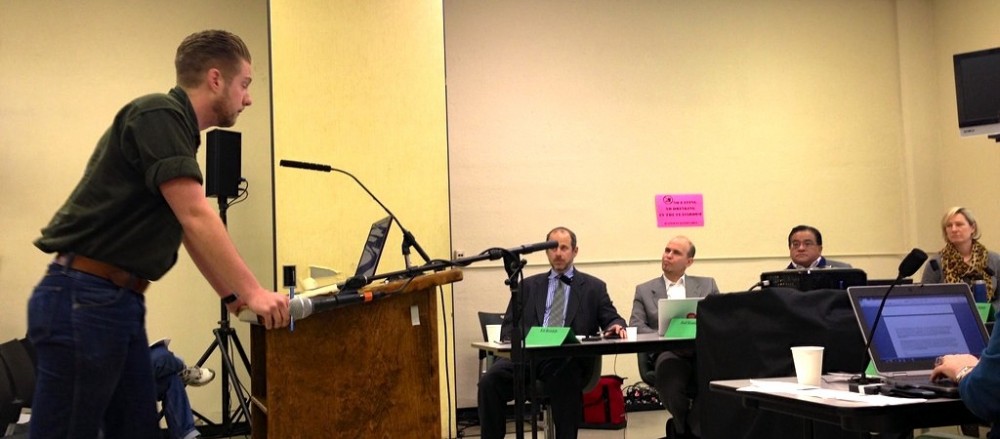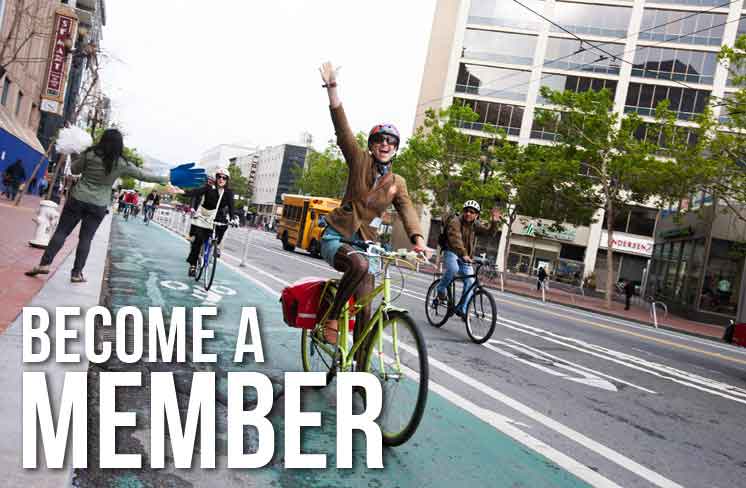Yesterday the SF Municipal Transportation Agency (MTA) Board of Directors held an all-day retreat to lay out the agency’s priorities for 2014. A single message emerged loud and clear as speaker after speaker urged the Board to prioritize safety and affordable transportation options on San Francisco’s streets.
It’s clear: the public wants street safety prioritized not merely in words, but in committing action and funding.
Stephanie Kwan, a 45-year-old who bikes with her two kids to school, told the Board that she does not bike out of “necessity,” but because she’s “practical” and it’s just easier and faster by bike. She estimates five other families bike regularly at the school of 500 students. Parents tell her that more would ride if there were calmer streets and more dedicated bikeways.
MTA Board members spoke strongly about the agency’s commitment to safety, and they unanimously passed a resolution supporting the Vision Zero policy of setting the goal of zero traffic deaths in 10 years. MTA staff admitted that bicycle and pedestrian projects have been “historically underfunded,” and they laid out grand visions and encouraging words for bike and pedestrian plans.
Many expressed frustration that these plans fell far short of real commitment to street safety. The MTA’s initial baseline budget — shared publicly for the first time here — looked dismally like business-as-usual, lacking a significant uptick in bicycle and pedestrian funding. Priya Sawhney of Central City Collaborative, a group that represents long-income tenants in the Tenderloin and SoMa, shared stories of seniors who are too scared of fast-moving traffic to even cross the street. “If we really believe in Vision Zero, it would be great to actually implement the plans,” said Sawhney.
MTA Board members seemed to recognize the disconnect between words and actions, and they directed staff to make safety a priority in this budget, which is being developed now and will be voted on in March. All eyes are now on the MTA to take action.
“We need to do whatever it takes to make this happen,” said Board Chair Tom Nolan, emphasizing the need to be mindful of our most vulnerable road users – seniors, kids and people with disabilities. “We just have to act as quickly as possible. This rises to the top as far as I’m concerned.” “Even if the transportation measures don’t pass, this is not something we can’t do,” said Board member Cheryl Brinkman, referring to the transportation funding measures likely to be on the November ballot.
Director Joel Ramos repeated concerns that a commitment to a Vision Zero policy was not strong enough. He directly asked staff for a commitment to implement 24 bicycle and pedestrian safety projects (one per month) within the next 2 years, as called for in the resolution they passed.
Supervisor Jane Kim’s legislative aide, Sunny Angulo, spoke at the hearing, to reiterate that 60% of traffic injuries occur on a mere 6% of our streets and should be preventable. She said the Supervisor is looking to the MTA Board to fund and commit to actions implemented by a Crisis Intervention Team as part of Vision Zero.
Unfortunately the call for action seemed to be watered down by MTA staff. Executive Director Ed Reiskin’s explanation of when and how near-term improvements on the city’s most troublesome streets (mostly in SoMa and the Tenderloin) would happen was unclear, at best. Instead of a lack of funding, he blamed the city’s long and cumbersome public process for re-allocating street space.
Reiskin’s behavior was in stark contrast to Police Chief Greg Suhr, who stepped up two weeks ago to commit to concrete actions in his department’s support for Vision Zero. Meanwhile, despite strong stated Board leadership, Reiskin continues to be noncommittal — at least publicly — in saying how his department will act on the street safety crisis at hand.
This lack of urgency and timely delivery of near-term street safety improvements from the MTA staff was a common theme throughout the meeting, with concerns raised by Board members and community members. The myth that “we’re going as fast as we can” is being questioned by people both inside and outside the agency. A recent report by the San Francisco County Transportation Authority detailed the chronic problems with project management at the MTA and other City agencies that work to improve transportation. These are long-known problems that the agencies have had in their power to fix for years, and still do.
The reality is that it will take real leadership to get the MTA to choose to really go after the vision the agency has set for itself through its Strategic Plan and the 2013-2018 Bicycle Strategy. It will require leadership to move away from funding biking at less than 1% of the agency’s budget and towards a budget that reflects the agency’s top strategic plan priority: “Create a safer transportation experience for everyone.”
Huge thanks to the many members and community leaders who took the time to speak about the importance of funding biking! It is absolutely crucial that these decision-makers hear from you. In fact, the SFMTA and Board of Supervisors will be voting on whether to fund biking or to maintain the status quo at a number of upcoming hearings. These decision-makers need to hear from everyone who cares about making our streets less chaotic and less stressful for everyone. Email kit@sfbike.org to get involved in the campaign to fund biking, and check out our earlier blog to learn more about what 8% for biking would mean for you.



